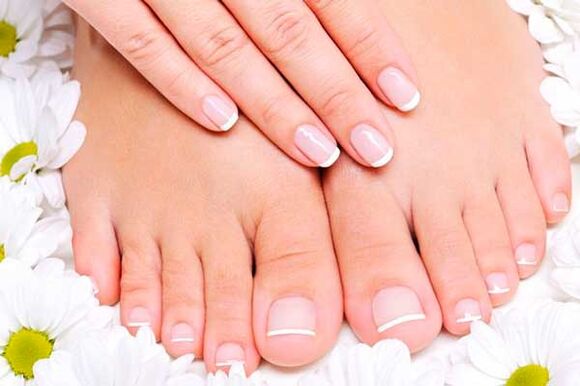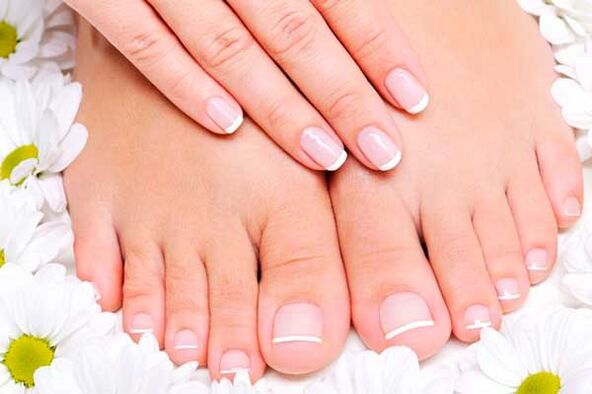
Toenail fungus is the most common and unpleasant disease. Fungal infections of the feet and nails do not cause significant health damage, but can cause a weakened immune system and unpleasant pain sensations.
Nail fungus is capable of concentrating toxic toxins in the body that multiply during the growth of the pathogenic fungus, causing slow poisoning of the body, which can cause allergic reactions or exacerbate chronic diseases. As a result, metabolic processes in the body are disturbed, immunity decreases, general physical condition deteriorates, and susceptibility to various negative environmental influences increases.
In this article, you'll learn what fungal spores are, the causes of this unpleasant disease, the signs and symptoms of damage, how to treat toenail fungus at home, and what precautions you must take to avoid infection.
Why do fungal diseases appear on toenails?
The occurrence of fungal infections can cause:
- Wounds on the feet in the form of cracks and abrasions, which may be the result of pedicure surgery or the result of wearing narrow and uncomfortable shoes;
- Corns and calluses on the feet;
- poor irregular foot care;
- decrease in immunity;
- Long-term use of antibiotics and drugs that have similar effects on the body during treatment;
- Excessive sweating of the feet;
The decline of the body's immunity and protective function can cause fungal diseases, but it is not the main factor in the pathogenesis.
First, an infection occurs:
- Contact with sick people (usually close relatives), through ordinary slippers or shoes, through household items - towels, sponges, rugs;
- In saunas, baths, swimming pools and on the beach. Large numbers of people and humid conditions lead to the spread of fungal diseases;
- Anywhere people walk without shoes. Fungal spores can withstand sudden temperature changes from low to high temperature and stay for long periods of time on sand, the surface of sidewalks, the upper surface of pools;
- When wearing someone else's shoes, pathogenic virus flora can survive and multiply in it;
- Wear stockings or socks made of synthetic materials that do not allow air to pass through, thus creating a favorable microclimate for fungal infections;
- The constant wearing of false nails makes the nail plate unable to breathe, which also contributes to the infection of fungal diseases;
Symptoms of Nail and Foot Fungal Infections
- dryness, itching, redness, and peeling of the feet;
- small itchy blisters between the soles and toes that may form corns - corns;
- Diaper rash on the legs due to increased sweating;
- Change the shape and color of your nails. The spores of the fungus penetrate the nail plate and gradually take root in it. The structure of the nail becomes uneven, brittle, and has an uneven surface. Where it fails, light or yellow spots appear with voids beneath them;
- Under the influence of toxic toxins produced by fungal spores, the legs sweat profusely, resulting in a pungent, unpleasant odor;
- Elevated body temperature is possible.
In case of cracking, itching, diaper rash, unpleasant smell on the feet, changes in the shape of the nails, white or yellow spots on the surface and gaps underneath, contact a dermatologist for detailed advice and treatment options. A dermatologist will tell you everything you need to know about treating toenail fungus at home, prescribe the right medication for each specific case, and give advice on using traditional remedies.

The symptoms of the disease and the nature of the lesions depend on the type of fungal disease:
- Types of fungal diseases - blisters, which begin to affect the lower part of the foot, characterized by the appearance of small fluid-filled air bubbles and blisters and the additional attachment of bacteria-pathogens;
- Types of mycosis - membranous, characterized by the appearance of small rashes and painful cracks with a red rash between the toes;
- Types of mycosis - similar to moccasins, where mycosis affects the skin of the feet, starting at the heel and ending at the toes. The lesions are accompanied by pain, thickening of the skin on the feet, cracks and itching.
Most of the time, fungal spores from the bottom of the foot are passed to the nail plate, where the fungus can take root and grow, affecting the nail. Fungal infections can negatively affect the entire body, inhibiting its function and possibly causing allergic reactions.
Treating Toenail Fungus At Home: Preventing Fungal Diseases
The most effective way to treat toenail fungus at home is a complex combination of special medicines and folk remedies for mycosis. First, let’s talk about what drugs are used to treat toenail fungus, and then talk about folk methods.
Medications must be used strictly according to the directions and administered continuously and accurately. For the treatment of fungal diseases, there are special antifungal drugs in the required doses. In advanced cases and extensive lesions, the fungus can be eliminated in several stages, observing certain temporary pauses between the course of treatment.
With the help of cheap and very effective drugs, fungi can be cured medically. There are ointments, gels and varnishes to prevent mycosis, which must be applied to the surface of the nail several times a day. The spores of the fungus are very resistant to its various effects, and in order to get rid of it completely, you will have to change your medication regimen regularly and alternate between medication and traditional medicine.
Treating Toenail Fungus At Home With Folk Remedies
Treating toenail fungus with folk remedies at home is the use of special natural remedies to regularly treat the area affected by the fungus. Fungal diseases are known to be acid-phobic, and the use of nature to treat fungi is based on this fact. The most effective natural remedies are vinegar, hydrogen peroxide, propolis, baking soda, iodine, garlic, kombucha. These are just means of negatively affecting the fungal pathogenic flora and being able to cope.
Treating Toenail Fungus With Vinegar
The vinegar treatment is carried out using a specially formulated emulsion containing vinegar, alcohol and glycerin. The ratio of the ingredients is appropriate - 2/2/1. Apply a piece of cotton wool or cotton pad soaked in the solution to the fungus-infected nail plate and leave it on for a certain period of time, then the feet must be dried with a clean towel or napkin before rinsing them with lukewarm water. Depending on the complexity of the lesions, a two-week to one-month lotion should be used. During such a treatment, the infected nail begins to fall off and fade away, and a new healthy nail grows in its place.
important! To avoid burning the skin around the affected nail, it is recommended to lubricate the skin with any vegetable oil before applying the lotion.
Treating Nail Fungus with Baking Soda
Baking soda is treated in the same way as vinegar, for this you need to make a cool solution of baking soda, dip a cotton pad in it and leave it on the affected nail for a while, then remove the disc and wipe the nail thoroughly with a dry towel.
Hydrogen Peroxide Fights Nail Fungus
Treatment with hydrogen peroxide is as follows: the peroxide must be poured into the void under the melaplatin, where the fungus has taken root. The aggressive and disinfecting environment of peroxide perfectly destroys the fungal spores and helps to get rid of the disease quickly.
iodine
Iodine treatment works very well and must be applied several times a day on the nail plate, fungal cavities should also be treated with iodine.
Propolis
Dressings of propolis tincture and alcohol are very helpful when treating fungus with propolis. Compression must be done daily and kept for a while, then rinse your feet with warm water. Such treatments should be performed until a positive result occurs and the nail is renewed.
Other folk remedies for onychomycosis
- Another effective but somewhat complex recipe is to apply a mixture of one teaspoon of methyl phthalate, one tablespoon of vinegar, one teaspoon of vegetable oil, and two raw eggs to the affected area. Mix all ingredients thoroughly and keep in refrigerator until fully used. Press the mixture onto your nails, wrap your fingers in plastic wrap, and put wool socks on them. Hold for at least thirty minutes.
- As a homeopathic remedy, a living organisms kombucha is very helpful. Throughout the night, place a tablet of kombucha on the affected nail and cover the area with plastic wrap. Kombucha has an acidic environment and can cope well with fungal spores.
- Treat the affected area daily with ground garlic for good results. Garlic juice is a natural disinfectant that is very effective against fungal spores.
Treating toenail fungus at home should be done regularly and methodically. If a small number of spores remain under the nail, the fungus will start growing again and all treatment must be restarted.
To avoid getting fungus from your nail plates and the skin of your feet, you need to take precautions, which we'll discuss later.
prevent disease
- In order to avoid primary or re-infection with fungal diseases, it is necessary to thoroughly and regularly dispose of all manicure tools and accessories. If the manicure or pedicure procedure is performed at a salon, make sure the therapist doesn't use untreated tools behind another person.
- Regularly clean your shoes with a disinfectant such as vinegar or formalin. For the best therapeutic effect on shoe disinfection, mix and treat these products with each other.
- Disinfect common household and household items from time to time by boiling in a soapy solution. For a solution, it is best to use a mixture of water, laundry soap, and a small amount of baking soda;
- Only wear special rubber slippers or flip flops in the bath, sauna and swimming pool.
- There are separate bath accessories - towels, sponges and towels.
- Regularly observe foot hygiene with the help of a drinking program. Wash your feet as often as possible with warm water, preferably with potassium permanganate crystals or a teaspoon of baking soda as a disinfectant.
- Do not try on, let alone wear someone else's shoes, as they are considered the best carriers of fungal diseases.
Successful treatment of toenail fungus at home can only be achieved by following all the recommendations of a dermatologist, strictly adhering to the regimen and use of medications, carefully observing the cleanliness of the lesions, and regularly performing all necessary disinfection procedures. Precautions and patience must be taken as nail mycosis is an insidious and intractable disease.
























